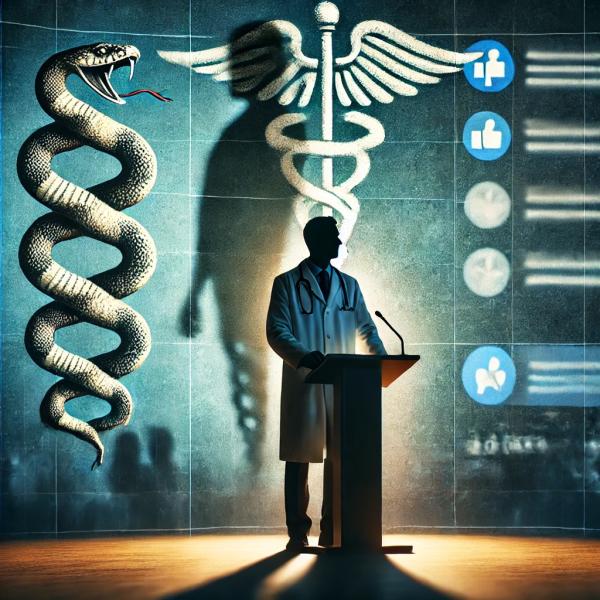
Many of the current nominees for the federal institutions of health, i.e., FDA, CDC, NIH, and HHS, have a checkered past, many being cited as providing false and misleading information during the murky days of COVID. While their pillorying and restoration have been chronicled in the media, and by that, I mean the digital versions of both “tradnews” and the Internet, little is known about the fate of physicians not in the public spotlight. A new study in JAMA examines the medical disciplining of “spreaders” of medical misinformation.
The data is derived from the actions taken by the five most populous State Medical Boards, California, Texas, Florida, New York, and Pennsylvania, from January 1, 2020, to May 30, 2023. The publicly available data was classified for the offenses leading to discipline, e.g., false claims or substance abuse, as well as for patient-directed falsehoods and public misinformation – a distinction we will return to shortly.
There were 3128 disciplinary proceedings involving 6655 disciplinary offenses. This included
- Practitioner negligence: 1911 offenses (28.7%).
- Problematic record-keeping: 990 offenses (14.9%).
- Inappropriate prescribing: 901 offenses (13.5%).
- Criminal activity: 599 offenses (9.0%).
- Alcohol or substance abuse: 320 offenses (4.8%).
- Inappropriate relations with patients: 198 offenses (3.0%).
There were six offenses for spreading medical misinformation to the public (0.1%). There were 21 offenses, nearly four-fold greater for spreading medical misinformation to patients. However, none resulted in license revocation, and the penalties were reprimands or probation. It is important to note that this included all forms of misinformation, whether COVID-related or not.
Certainly, there is no evidence of a witch hunt or a conspiracy by practitioners or medical institutions to censor speech as we have seen in, say, the 1497 Bonfire of the Vanities in Florence. Despite these low numbers, the researchers remain perplexed and concerned. As they conclude,
“The study results have serious policy implications, suggesting that the professional licensure system under current patient-centered frameworks may be institutionally ill-suited to combat the diffuse, intractable, and largely public health-related harms arising from physician-spread misinformation.”
While they correctly point out that misinformation may be ambiguously defined based on the goal post choices of scientific consensus, peer-reviewed literature, or expert guidance, determining what counts as false or misleading is challenging, especially in areas with limited evidence, like emerging diseases. They go on, wrongly, in my opinion, to suggest that State medical boards, chronically underfunded and resourced, prefer to go after the more provable long-hanging fruit, such as negligence, poor record keeping, and inappropriate prescribing.
I would argue that those specific physician wrongs can be far more immediately harmful. My argument is bolstered by the finding that in those cases involving discipline over misinformation, patient-centered misinformation was most concerning in the state board’s actions. My public utterances are essentially covered by the First Amendment, even though those MD initials after my name may impart an unwarranted halo of expertise and care. On the other hand, in my communications with my patients, I have a fiduciary responsibility to act in their interest alone so that when sharing treatment options, I have a duty to provide context and not solely offer my “considered” opinion.
The researchers write that “the harms arising from misinformation to the community may seem too diffuse and predicated on only an indirect causal connection to the physician’s actions compared to falsehoods with patients,” but then offer without evidence (a phrase we hear more and more frequently), that
“Medical boards’ seeming preference for regulating patient-facing conduct can lead to inefficient, poor policy, however, because spreading misinformation publicly may inflict wider damage.” [emphasis added]
America’s physicians, chosen to attend medical school and residency training by meeting exacting and pre-specified standards, meeting and exceeding the tests, are curated to do as instructed. We have seen this time and time again in the dramatic reduction, even if ill-advised, to reduce opioid prescribing and again and in carefully offering our best medical advice to the dynamics of an ever-changing virus. Rather than seen as a failure to police our brethren adequately, I believe the data dots suggest that we acted as a group in the best clinical interests of our patients; we did no harm.
Others will contend that our collective response overrode dissenting medical opinion; again, the numbers here reflect that dissenters were overpunching for their weight class, at least regarding the physician’s role with individual patients. The researchers’ concerns about public misinformation inflicting “wider damage” cannot be inferred or refuted by their current work. Finally, the public utterances of physicians, unlike the multitude of voices expressed on the Internet, are attached to identifiable individuals; there is no Dr. Anonymous – in that sense, physicians remained free to exercise their First Amendment rights while also carrying out their First Amendment responsibilities of standing by their word.
So, what have we learned? That medical boards are more comfortable swatting at the low-hanging fruit of negligence and record-keeping errors than tackling the thornier issue of public misinformation. Maybe that’s because actual harm in patient interactions is easier to quantify—or maybe they just prefer their fights to come with a clear checklist. Either way, for all the clamor about "censoring free speech," the data suggests that physicians who dabble in public misinformation are more likely to get a wrist slap than a career-ending gavel drop. For those, dabbling in misinformation to their patients, we have both state medical boards and malpractice suits.
Source: Medical Board Discipline of Physicians for Spreading Medical Misinformation JAMA Network Open DOI: 10.1001/jamanetworkopen.2024.43893



